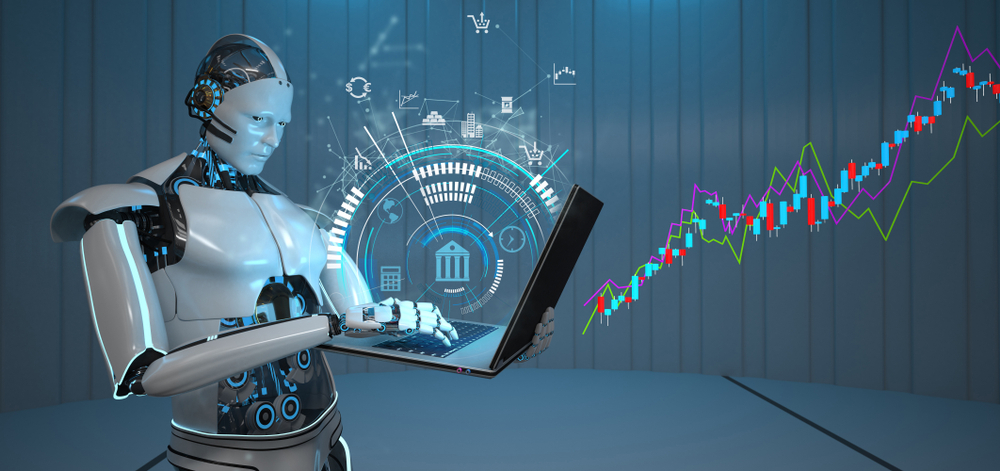Nel 2025 le tensioni sul commercio globale si sono nuovamente surriscaldate e i mercati finanziari hanno subito forti oscillazioni in risposta ai nuovi dazi, alle dichiarazioni politiche e al cambiamento del sentimento degli investitori. Mentre gli investitori tradizionali possono guardare a questa volatilità con cautela, un altro gruppo sta prosperando nel caos: i trader algoritmici, noti anche come robo-trader.
These automated systems, powered by artificial intelligence and quantitative models, are uniquely positioned to exploit the very market conditions that shake human confidence. With the recent escalation in tariff rhetoric—particularly between the United States, China, and parts of the European Union—robo-traders have stepped into the spotlight, quietly profiting from every spike, drop, and rebound.
Let’s take a closer look at how these systems work, why they’ve become more effective in times of uncertainty, and what this means for the average investor.
La volatilità come motore di opportunità
Tariff wars tend to fuel short-term fear, uncertainty, and headlines. Markets react instantly—sometimes irrationally—to policy announcements, retaliation threats, and economic indicators. This creates a fertile environment for high-frequency trading (HFT) systems and algorithmic strategies designed to detect and act on minute price inefficiencies within milliseconds.
All'inizio del 2025, quando gli Stati Uniti hanno annunciato dazi aggiuntivi sui componenti dei veicoli elettrici e sui semiconduttori importati dall'Asia, i mercati azionari hanno subito registrato una flessione nei settori correlati. In pochi minuti, gli algoritmi hanno aggiustato le posizioni, sfruttato le discrepanze di prezzo tra le borse mondiali ed eseguito migliaia di operazioni basate sull'analisi del sentiment e sul riconoscimento dei modelli.
According to data from Refinitiv, daily trading volume on U.S. exchanges jumped by over 25% in the days following key tariff announcements, with a significant portion of that volume driven by automated strategies. Meanwhile, volatility indexes like the VIX surged above 20—levels not seen since mid-2023—providing further fuel for short-term strategies.
Perché gli algoritmi prosperano quando gli esseri umani esitano
The strength of robo-traders lies in their speed, objectivity, and scale. They don’t panic when headlines scream “Recession Warning” or “Global Trade War Escalates.” Instead, they process data—news sentiment, price momentum, macro indicators—almost instantly, executing trades without emotion.
These systems are designed to profit not from long-term fundamentals but from micro-movements. A sudden tariff-related drop in a specific stock or currency might be seen as a temporary mispricing. Algorithms step in, place trades across multiple instruments, and close positions within seconds or hours—often before human traders have even reacted.
Firms like Renaissance Technologies, Two Sigma, and Citadel Securities have long relied on such strategies, but even smaller, tech-driven hedge funds and retail platforms are increasingly deploying AI-powered systems. As of 2024, it’s estimated that over 60% of U.S. equity trading volume is now driven by algorithms—and that figure is rising globally.
L'equazione rischio-ricompensa
Of course, algorithmic trading isn’t risk-free. These systems are only as good as the data and models behind them. Unexpected regulatory changes, sudden liquidity shocks, or errors in code can lead to cascading losses, as seen in past “flash crash” events. But when managed properly, their edge lies in their consistency and scale.
In the current environment—where tariffs create uncertainty and central banks are still grappling with inflation—the combination of volatility and liquidity is ideal for quantitative trading. While long-term investors worry about earnings downgrades and supply chain disruptions, robo-traders are exploiting the inefficiencies created by those very concerns.
Some estimates suggest that quantitative hedge funds have outperformed discretionary managers by 2–4% in Q1 2025, largely due to their ability to trade quickly around geopolitical news and policy swings.
Cosa dovrebbero imparare gli investitori al dettaglio
You don’t need to run your own robo-trader to benefit from these insights. But understanding how they operate can help you navigate markets more effectively. If nothing else, it’s a reminder that volatility isn’t always a threat—it can also be an opportunity.
Gli investitori al dettaglio possono trarre insegnamento dalle strategie algoritmiche rimanendo sistematici, disciplinati e informati sui dati. Invece di reagire emotivamente a ogni movimento del mercato, si può pensare di adottare un approccio al ribilanciamento del portafoglio basato su regole o di utilizzare strumenti di investimento automatizzati che seguano una strategia definita.
And for those interested in exploring this world further, some robo-advisory platforms now offer exposure to volatility strategies or AI-driven funds—bridging the gap between human and machine for everyday investors.
Trasformare le turbolenze del mercato in intuizioni di mercato
As the tariff war unfolds and market conditions remain turbulent, one thing is clear: technology is playing an increasingly central role in the way money moves. Algorithmic traders aren’t just weathering the storm—they’re thriving in it.
While most of us won’t compete on speed or scale, we can still learn from the mindset that powers smart systems: data over drama, process over panic, and long-term thinking in a short-term world. In times of uncertainty, that’s a strategy worth remembering.

